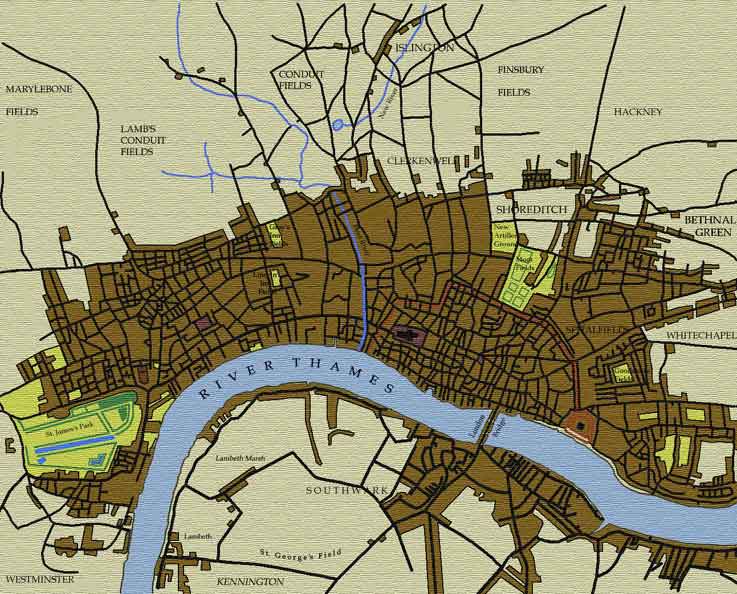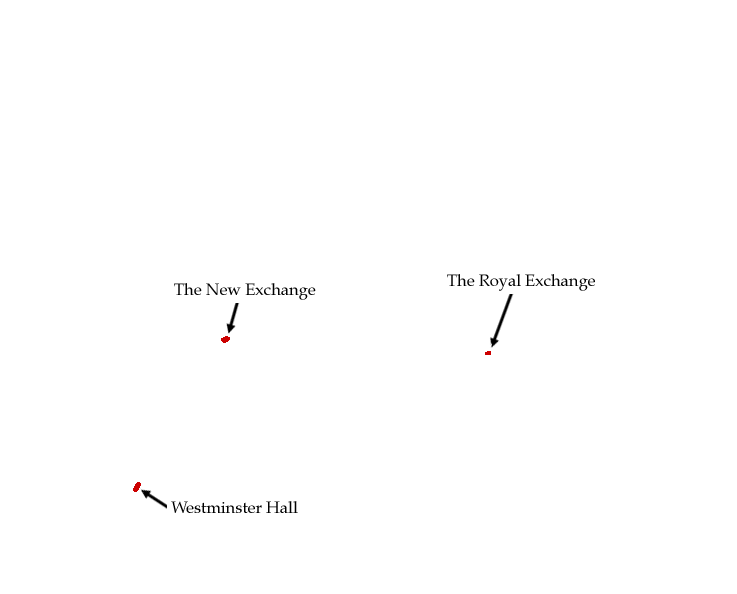


London ca. 1676
The Royal Exchange and the New Exchange
|
London in the Restoration and eighteenth-century
was a boom town, and, for those seeking luxury items, featured a number
of attractive and fashionable venues for shopping. The most important
of these were the two Exchanges, which functioned rather like 19th-century
shopping arcades, or the modern high-end shopping mall. Another central
shopping centre was located at Westminster Hall, in close proximity to
the nation's principal law courts. |
|
The Royal Exchange The Royal Exchange had been built
in 1567 by Thomas Gresham, who was impressed by the prosperous bourse
at Antwerp, and wished to provide for London a business centre that would
rival that of the Dutch. Gresham proposed building it at his own expense,
and the City corporation donated the land, demolishing eighty houses on
the site to clear sufficient space. The first Exchange was colonnaded,
with shops on the first floor, surrounding an open courtyard; it became
known as the Royal Exchange when it was officially opened for business
by Queen Elizabeth. Gresham's ambitions for the building were finally
realized in the seventeenth-century, for the Royal Exchange was to become
an immensely important centre for business and retail, and helped fuel
London's rise as a commercial centre. Gresham's Royal Exchange was destroyed in the Great Fire, and rebuilt according to a design, owing much to the original layout, by Edward Jerman in the mid-1670s. It remained a highly fashionable retail and social venue for the duration of the eighteenth-century, and was burned down in 1838.
The New Exchange was not at first terribly successful, and, in an effort to recoup expenses, its bottom floors were rented out as residences. However, with the development of Covent Garden and Lincoln's Inn Fields, and with the loss of shops and the Royal Exchange in the Great Fire, it became a very fashionable place to shop, and to socialize: references to it in Restoration comedy are almost obligatory. It included some excellent book shops. Its appearance during the Restoration was described by the visiting Grand Duke Cosmo of Tuscany:
The New Exchange was divided into four sections, with an "Outer Walk" and "Inner Walk" on each of the two floors ("Above" or "Below Stairs"). The lower floor had a reputation as a place for romantic assignations. The vogue for shopping in the New Exchange was, however, relatively short-lived, and the place lost much of its lustre in the reign of Queen Anne; it was taken down in 1737.
|
 |
Website maintained by: Mark
McDayter
Website administrator: Mark McDayter
Last updated: April 25, 2002